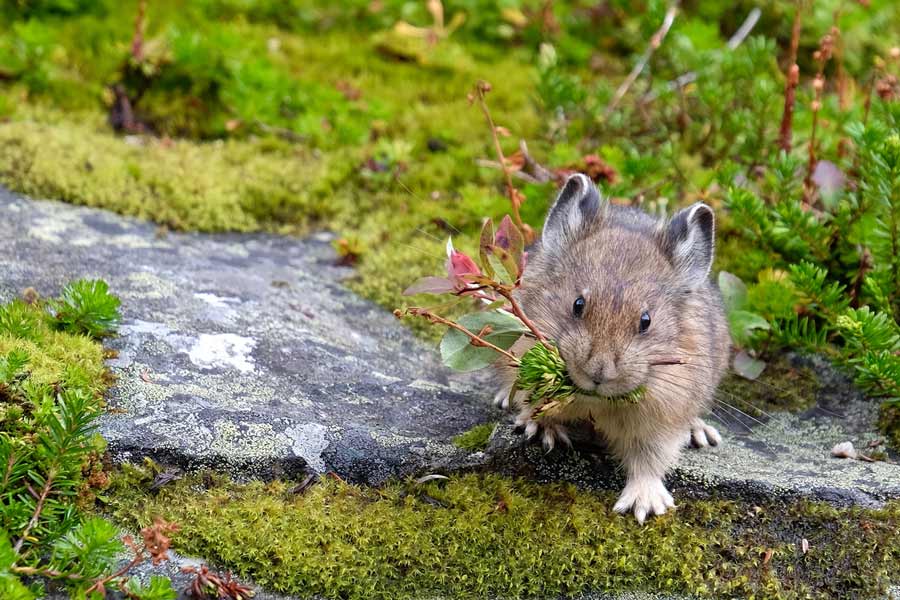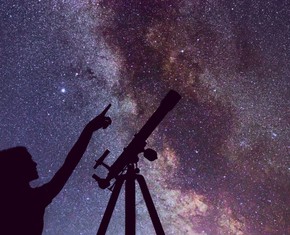The views expressed in our content reflect individual perspectives and do not represent the authoritative views of the Baha'i Faith.
I’ve always loved the mountains. A mountain climber by the age of 19, I wanted those peak experiences, gazing out at the world from its highest places.
When I go hiking or climbing in the Sierra Nevada range near my home in California, I like seeing a little hamster-sized relative of the rabbit called a pika. Have you ever seen one? Unless you’ve lived at or travelled to high altitudes, probably not—pikas love cold weather, crisp clean air and mountain living, just like mountain climbers everywhere.
A pika looks like a furry baby rabbit with smaller ears and no tail. They sit up on their hind legs, alert, perky and bright-eyed. Some people call pikas “whistling hares” because of the high-pitched alarm call they make right before they dive into their burrows. In the spring, male pikas sing complex, haunting songs to attract their mates. They live in high mountains like the Sierras or the Himalayas in Tibet, uniquely suited to the long winters, the cold temperatures and the scarce food sources. Scientists say pikas are the mammals most adapted to the world’s highest altitudes.
Cute little guys, pikas are friendly, too. They’re not usually scared of humans—probably because they see so few of them at their altitude—so they’ll come right up to you, wiggle their noses and say hi. (Well, not really—I’ve never actually heard one speak, except in my imagination …)

Pikas usually make their dens among rocky mountain slopes or talus fields, and they’re always busy gathering food when it’s warm, using the summer months to line their rocky dens with grasses, flowers and twigs, which they eat during the winter months. At those high altitudes, summers are only a few months long, and the snow and ice come early and stay late.
You can probably understand, now that you know a little bit about the pika, why I’m grieving their loss.
A new scientific study led by the biologist Joseph Stewart from the University of California has just determined that we’re living through the largest American pika die-off in history. Reported recently in the research journal PLOS One, the six-year study determined that no more pikas existed in a 165-square-mile area of the Sierra Nevada mountain range near Lake Tahoe, the Truckee River and Mount Pluto in the Granite Chief range—an area that previously held one of the largest pika populations on Earth:
When we found old pika poop in every talus field that we looked at along the Truckee River, which is super low elevation, we started scratching our heads. If there is old pika poop there, where did the pikas go? Are they at higher elevations? The next six years we surveyed at progressively higher and higher elevations (Mount Pluto’s peak is at 8617 feet) until we realized that, oh my God, pikas are extinct from this whole huge area. – UC biologist Joseph Stewart, quoted by Claire Cudahy in the Sierra Sun, September 20, 2017.
Slowly, the pikas are dying. Here’s why: these small, compact six-ounce animals have a very high metabolic rate, which keeps them warm during the cold winters. They’re hot little guys—their normal body temperature is 40 degrees Celsius, 104 degrees Fahrenheit—which makes them uniquely vulnerable to overheating and dying when they’re actively gathering food during periods of warmer-than-normal weather. Studies show that the upper critical limit of a pika’s ability to survive is three degrees Celsius above their normal body temperature. They love the cold, but they can’t take the heat.
As the world warms, you could think of the pika as the modern-day equivalent of the canary in the coal mine:
“I think the pika can be an ambassador species for species that are vulnerable to climate change,” Stewart said. “It’s indicative of a very worrying trend. If we don’t reign in global warming pollution, about a million species or 15 percent of species on Earth are vulnerable to extinction from climate change,” said Stewart, citing a 2015 study published in Science. – Ibid.
Why should we care about this small animal that most humans will never even see? Well, you’ve heard the old phrase “canary in a coal mine?” We should care about the pikas for the same reason that coal miners cared about the canaries they used to carry in cages into the mines. When their canaries perished, it meant the toxic gases in the mine were about to reach fatal levels for humans, and the miners quickly got out. I’ve come to the conclusion, as have multiple biologists and climate scientists, that the pika is our world’s canary.
The main reason I’ve always sought the solitude and beauty of the high mountains is a spiritual one. I found solace there. I could see the untrammeled, unspoiled work of the Creator, breathe the clean air, gaze out into the distance—and all those things made me happy. Today, though, I feel grief, because humanity is undoing all that. We have failed to recognize or adequately account for the collective impact seven billion people can and do create on all other life. We have, with our materialistic, profligate and profit-addled civilizations, dumped so much carbon into the Earth’s atmosphere that it now kills small, innocent animals. The pikas in our high mountains know nothing about climate change, but their complete and total extinction isn’t far away, unless we take collective action as a species to stop it.
How can that happen? The Baha’i teachings say it can only occur when we decide to unite the world:
God made religion and science to be the measure, as it were, of our understanding. Take heed that you neglect not such a wonderful power. Weigh all things in this balance ….
Put all your beliefs into harmony with science; there can be no opposition, for truth is one. When religion, shorn of its superstitions, traditions, and unintelligent dogmas, shows its conformity with science, then will there be a great unifying, cleansing force in the world which will sweep before it all wars, disagreements, discords and struggles—and then will mankind be united in the power of the Love of God. – Abdu’l-Baha, Paris Talks, pp. 145-146.
Our unity, if we let it, can stop wars, create an equitable and just global government, protect all life and help slow the forced march humanity is now making toward the sixth great extinction, what scientists term the Holocene event—a precipitous, universal, cosmopolitan and global decline in biodiversity. This current rate of the loss of species includes almost every family of animals and plants, and is between a hundred and a thousand times higher than normal.
In this series of essays, we’ll explore the Baha’i teachings about stopping that extinction.
You May Also Like
Comments

















In Canada we have built city's on most of our farm land and with it getting warmer we will be able to farm farther north.
It is in the writings that the north will be come, great vineyards, to me this means that it is going to get warmer.
We must look at ...the good, and trust in God, teach the faith, the faster it grows the sooner things will get better.